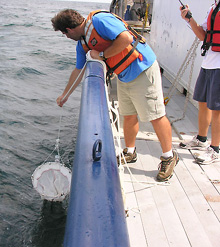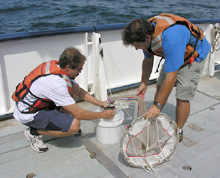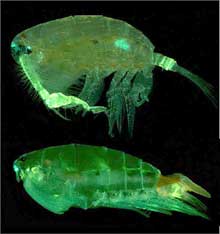
The pontellid copepod Pontella securifer. Various parts glow fluorescent green when viewed under blue light. TOP: Note the male's specialized antenna and claw on its last leg (on the right) for grabbing females. BOTTOM: The female has an oblong sperm packet attached at her tail. Click image for larger view and credits.
Shallow Scope
August 26, 2005
Jon Cohen, Ph.D.
Harbor Branch Oceanographic Institution
Latitude: 29° 07.657' N
Longitude: 90° 13.088' W
The winch used to lower the submersible into the sea is not working properly, so we have steamed to Fourchon, LA to get parts. The engineers and sub crew on the Seward Johnson are quite good at fixing broken equipment, but they were unable to fix the winch using the parts we had on board. Such happenings are all part of going to sea, and the science crew is taking things in stride.
Does all science stop because we are temporarily without the submersible? No way! As the sun was setting yesterday evening over Vioska Knoll, Mike Matz and I towed a net to catch zooplankton (small critters about 1-10 mm). The word "plankton" is derived from a Greek word meaning "to wander or drift." These animals are not large enough to swim against horizontally moving ocean currents but many are capable of swimming vertically in the water column over large distances. Zooplankton often swim up into surface waters during the night and down into deeper water during the day. By setting the net during the evening we were able to catch some of these migrators, as well as other zooplankton that live permanently at the surface.
Our catch included many interesting little creatures, including many species of copepods. Copepods are crustaceans, and are extremely abundant in the oceanic plankton. While most copepods have very simple eyes consisting of a few clusters of photoreceptor cells, copepods in the family pontellidae have more elaborate eyes which often include interesting arrangements of lenses. We caught some of these colorful pontellid copepods, including one species (Pontella securifer) that is also strikingly fluorescent.
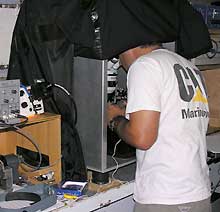
A copepod being prepared for an electrophysiological experiment. Dr. Cohen is placing a copepod in an experimental chamber and inserting the recording wire into the photoreceptor cells. Click image for larger view and further details.
I am interested in what uses these simple little creatures have for such complex eyes. To begin to answer this question, on this cruise I am looking at the sensitivity of pontellid copepod eyes to different colors of light using a technique called electrophysiology. This involves measuring the slight changes in electrical current generated by the photoreceptor cells of the eye when they are exposed to a brief flash of light. Copepod eyes have never been studied using this technique, which is likely due to their small size. These measurements require the copepod to be delicately glued to the head of a small pin and submerged in seawater with only the eye above water. I then insert a fine wire beneath the lens and into the cluster of photoreceptor cells. I present the copepod with a series of light flashes varying in color and intensity, and the electrical activity of the cells can be monitored using an amplifier and a computer. Keep in mind this is all being done on a rolling ship; it takes patience!
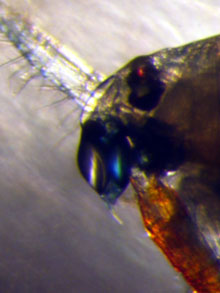
Profile of the head of the pontellid copepod Pontella securifer. Light passes sequentially through 3 separate lenses and then hits the photoreceptor cells. Click image for larger view and further details.



























